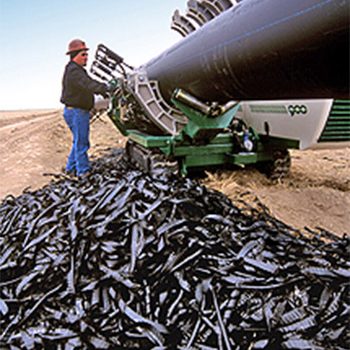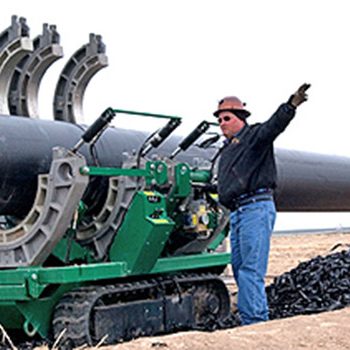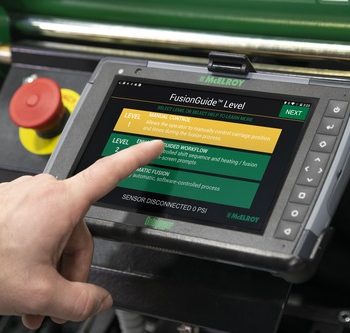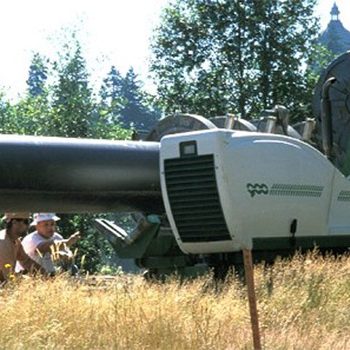Fairfield Idaho, 2005 — Brian Shields pulls his truck to the side of a rural Idaho highway to fire up his Pocket PC, check his GPS and talk on his headset phone. He is stroking his Fu Manchu while finalizing another pipe deal and looks more like one of the Hells Angels than a technically advanced traveling sales rep. Shields hangs up, sits and stares over the steering wheel at his big-sky office. Rows of irrigation sprinklers cover green alfalfa fields sprawl to the distant Sawtooth Mountains that punctuating the horizon. “Nature didn’t plan for this country to be so green,” he says, indicating that only 8 to 12 inches of rain falls annually and not even that much during the last seven years of record drought. “But smart farmers have always figured out a way to make this land produce; I’m just glad that polyethylene pipe is becoming a part of the equation.”
Shields is talking about a 19,000-foot high density polyethylene (HDPE) pipeline that will replace an open irrigation ditch for a conservation-minded farmer. The pipeline will not only conserve precious water, it is an energy saver, and the federal government is so impressed with the project that it is paying for half of the construction cost.
In the mid to late 1800’s, the sagebrush country of Southern Idaho held great potential for homesteaders. The soil was rich but lacked one crucial element to produce crops — water. What was worse, a huge volume of water flowed unchecked down Idaho’s rivers through the arid lands and out of the state. As early as the 1850’s, farm entrepreneurs hand-dug crude ditches to bring river water to small farms where they grew vegetables and other crops to sell to miners flocking to the gold rush bonanza in the high county. This system has grown into thousands of miles of canals, laterals and irrigation ditches that are responsible for a $5.3 billion agriculture economy. What’s more, many feel ditch irrigation is the most significant activity in the history of Idaho and consider it the key that truly unlocked the West.
Nature didn’t plan for this country to be so green
The use of polyethylene pipe to replace open ditches is the latest evolution in Idaho’s rich history of crop irrigation. The benefits of having a pipeline instead of an open ditch can be staggering. For instance, water is traditionally pulled from the ditches with pumps. The fuel expense for pumps alone can take a huge bite out of the bottom line. Primo Farms, the 6,000-acre family farming operation that is installing the pipeline, uses 80,000 to 100,000 gallons of diesel fuel each year in pumps that bring water to its crops. The pipeline will be gravity fed which will eliminate the need for pumps. This will save close to $200,000 in overhead for the farm and is the kind of energy conservation that intrigued the government.
Third generation farmer, John Pratt of Primo Farms, discovered that the National Resources Conservation Services (NRCS) had a program that would match funds for farmers that were implementing energy saving practices into their farming operation. One of the specifications is that the project has to be a 100% energy-replacing project to qualify for the funding. Since the pipeline will completely eliminate the pumps, it passed the criteria.
“We did a feasibility study to find out how much money we could save and determined we could pay for the pipeline with the savings in diesel fuel in three years,” said Pratt. “The government grant for energy conservation was just an added benefit along with the value of the land which will greatly appreciate with the new pipeline.”
Pratt feels that perhaps the strongest benefit of the pipeline is the amount of water it will conserve. Farmers in the area are allotted a certain amount of acre-feet of water based on water levels in nearby Cedar Mesa Reservoir. Once the allotment is used, the landowner can have no more water.
“Water is everything in the West and our holding reservoirs are low,” said Pratt. “Farmers have to learn how to embrace technology that conserves water if they’re going to make it.” Farmers in the area order water for their fields from Cedar Mesa Canal System. The water company releases water through the canal system through gates to each farmer’s irrigation ditches. The water company may have to release double the amount of water that the farmer requests to allow for “ditch loss” before the water reaches the farmers head gate. Ditch loss is water that evaporates or seeps into the ground while in the ditch.
“The pipeline will save about 25% of the water we use and that 25% could make up the difference between a poor crop, and a bumper crop,” said Pratt. Pratt believes that the pipeline is just another effort to be responsible for the land and water much like the use of sprinkler systems, which he exclusively uses instead of flood irrigation. It is estimated that sprinklers use 40% less water than flood irrigation.
Pratt first discovered HDPE when a neighboring farmer was installing the pipe for the same kind of project. He was impressed with how easily the pipeline was installed and that it would require almost no maintenance in the future. That’s when he decided to find out more and called Brian Shields with High Country Fusion based in Fairfield Idaho. Shields supplied the HDPE pipe, McElroy fusion equipment, and trained Pratt in the butt fusion procedure.
Butt fusion is the process of using heat and pressure to connect polyethylene pipe end to end. The ends of the pipe are melted with a heater and after it has become molten, the pipe ends are pressed together and held until the melt cools. The resulting joint is stronger than the pipe itself so the pipe has no joint and becomes a monolithic structure.
“With fused joints, the pipe line has no weak link so there are no leaks,” says Shields. “HDPE pipe has proven itself over the last thirty years in the gas industry and is starting to make a big impact in the water industry. The farm irrigation industry is a natural fit.”
Shields points out that since farm irrigation is by far the largest consumer of water in the West, it is the area that conservation measures can have the greatest affect. The battles over water control in the state are becoming heated and law practices that specialize in water law are among the most successful in the state. An entire section of Idaho Code is now devoted just to water. He feels that as water becomes more valuable and the news of these types of irrigation pipelines spreads, the door will open for HDPE to become a strong solution to the water shortage problem and ultimately make his job of selling the pipe easier.
In the 160 years since water was first used on the Idaho frontier, there has evolved a sophisticated network of thousands of miles of canals, laterals and ditches. There are literally hundreds of irrigation districts, ditch companies, canal companies and other entities directly involved with the delivery of water from river to land. With the shortage of water, battles over control of the water will grow and farmers who adopt the latest technologies like HDPE will prevail and continue to make the land produce.
“Water has defined and shaped the lives of the people in rural Idaho ,” said Shields. “Some farmers are starting to improve their operations by the way they conserve water, but no matter how they decide to deal with the shortage, the task of learning about and accepting new technology, pales in comparison to the pain sweat and struggle experienced by the pioneers that first decided to make this land produce.”



